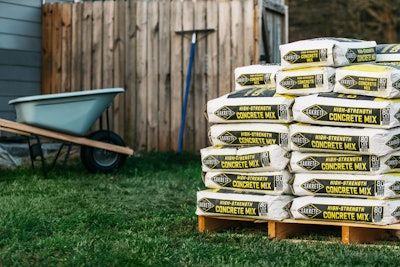
You might hear it from clients all the time: If the city can patch streets and sidewalks any time of the year, then why can’t they place concrete for a new driveway during the dead of winter too? A sensible answer, of course, is that a stretch of road or sidewalk needing constant repair might tell you all you need to know about the job’s quality. Poor weather is dangerous for concrete, and pouring it without optimal conditions often means it will need more repairs down the line.
Even so, no one has the luxury of working in ideal temperatures or perfectly sunny days all the time. Though you may already know about some common weather hazards in the concrete world, you may not know about potential solutions. There are several strategies for mitigating the issues that even slightly inclement weather can bring, but there are also scenarios where it’s usually best to just halt work and wait for a more suitable day. Knowing when and how to explain these issues to clients can be valuable as well.
Temperature
Concrete is a fickle beast. It’s best to set up expectations early, as well as explain how projects large and small can go downhill quickly with even slight fluctuations in temperature. In the best conditions, concrete will take between four and six hours to set – perhaps as many as eight. But if the temperature drops to even a relatively cool 50 degrees, concrete will need about 10 hours to properly set. As the time window expands, problems can be compounded.
When the surface temperature and the air temperature are in the freezing realm, concrete simply can’t be placed properly. If concrete freezes, you’ll lose half of the 28-day cure strength, potentially leaving it too weak for its intended application. When the surface is frozen, you can try thawing it out with heaters prior to placing the concrete, but then the placement becomes difficult to maintain and control. (Don’t even think about trying antifreeze – it will ruin your concrete entirely.) Another potential solution for placing in colder climates is using a magnesium-phosphate based concrete mix, which is often used to place highway road repairs and in big walk-in freezers. This kind of mix can generate enough heat to boil an egg, making it useful for environments where cold temperatures can’t be avoided. However, these mixes are often expensive.
If you absolutely must work through cold temperatures, a concrete blanket is often the best way to retain heat. Concrete will naturally generate its own heat thanks to chemical reaction as it sets (known as “kicking heat”). If you can get a blanket for the concrete, it will serve as an insulator and contain the much-needed heat. Even so, the best time to place concrete is when air, mix and substrate temperatures are between 40 and 90 degrees, with no rain in the forecast within 24 hours of application.
Extremely high temperatures will cause problems of their own by prompting concrete to set too quickly. If it flash-sets, you’ll lose the mix as you’re placing and end up with cold joints between the pours. High heat puts the project at big risk and when the concrete hits its first freeze cycle, it will crack the cold joints. One potential remedy is using ice water to retard the set time, giving you more opportunity to work with it.
Rain
Then there’s the problem of rain. If there’s a severe downpour and too much groundwater gets into the concrete, the concrete will weaken. To avoid this problem, you’ll need to cover off the area and try to keep the rain as far from it as you can. If the concrete has time to set and you can keep the penetrating water from getting to it, this will keep your pour from becoming weak. So, keeping it covered is crucial.
Tell clients when they spot tree roots or debris in the slab, not to mention some cracks sprouting, there’s no time to wait. A professional needs to open the concrete up and do repairs to keep moisture from seeping in. When damage is definitively identified, it’s time to determine the extent of it to figure out what needs to happen next. To get a reliable idea of how deep the issues run, pressure washing is a good place to start. If that chews up the concrete, it needs to be removed. If it leaves you with a stable substrate, then you can look into resurfacers. These aren’t too difficult to use, as long as you have a clean and sound substrate.
Apply a Sealer
So how can you encourage homeowners to maintain their concrete? Let them know how important it is to seal it – and not just once. Lots of people think that once they’ve put the sealers down, they’re set forever. But the truth is, a lot of sealers don’t even last six months. UV rays and other elements can hit concrete hard, so the best thing any owner can do for their concrete is keep it clean and maintain the sealer.
No matter what kind of issues a client is dealing with, one of the most important pieces of advice you can give is to encourage them to seek help from the professional when it’s necessary. Though a DIY approach can save some money, it’s often not worth the hassle (or mess) in the end. Concrete, after all, is hard work, and plenty of new users are surprised at just how difficult it can be to mix and apply properly. Too many inexperienced DIYers attempt to add extra water to their concrete mixes, making it easier to work with but disastrous once it sets. Ultimately, concrete requires the skill and expertise of someone who understands potential hazards and is prepared to deal with them.
About the author
Mike Boenisch is the Manager of Technical Services/Risk Management at Sakrete of North America at Oldcastle.


















